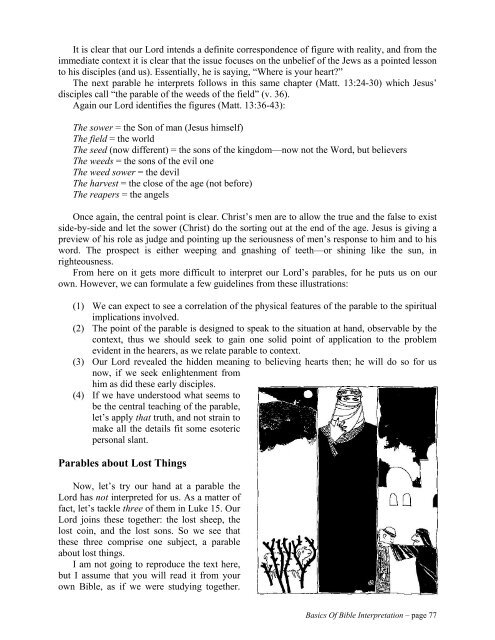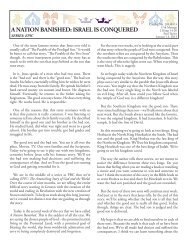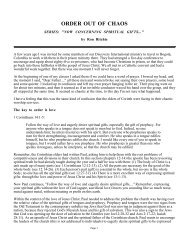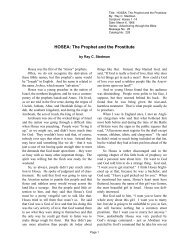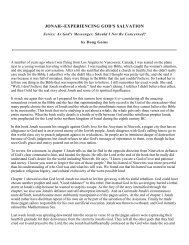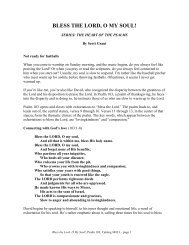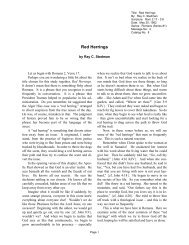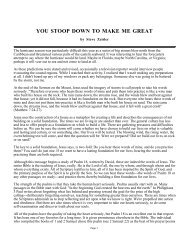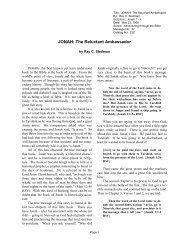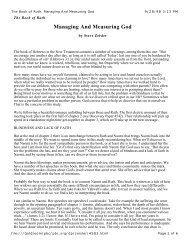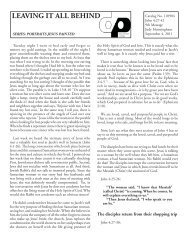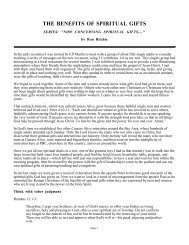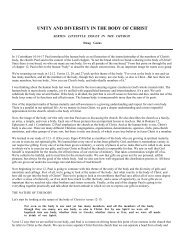Basics of Bible Interpretation - RayStedman.org
Basics of Bible Interpretation - RayStedman.org
Basics of Bible Interpretation - RayStedman.org
Create successful ePaper yourself
Turn your PDF publications into a flip-book with our unique Google optimized e-Paper software.
It is clear that our Lord intends a definite correspondence <strong>of</strong> figure with reality, and from the<br />
immediate context it is clear that the issue focuses on the unbelief <strong>of</strong> the Jews as a pointed lesson<br />
to his disciples (and us). Essentially, he is saying, “Where is your heart?”<br />
The next parable he interprets follows in this same chapter (Matt. 13:24-30) which Jesus’<br />
disciples call “the parable <strong>of</strong> the weeds <strong>of</strong> the field” (v. 36).<br />
Again our Lord identifies the figures (Matt. 13:36-43):<br />
The sower = the Son <strong>of</strong> man (Jesus himself)<br />
The field = the world<br />
The seed (now different) = the sons <strong>of</strong> the kingdom—now not the Word, but believers<br />
The weeds = the sons <strong>of</strong> the evil one<br />
The weed sower = the devil<br />
The harvest = the close <strong>of</strong> the age (not before)<br />
The reapers = the angels<br />
Once again, the central point is clear. Christ’s men are to allow the true and the false to exist<br />
side-by-side and let the sower (Christ) do the sorting out at the end <strong>of</strong> the age. Jesus is giving a<br />
preview <strong>of</strong> his role as judge and pointing up the seriousness <strong>of</strong> men’s response to him and to his<br />
word. The prospect is either weeping and gnashing <strong>of</strong> teeth—or shining like the sun, in<br />
righteousness.<br />
From here on it gets more difficult to interpret our Lord’s parables, for he puts us on our<br />
own. However, we can formulate a few guidelines from these illustrations:<br />
(1) We can expect to see a correlation <strong>of</strong> the physical features <strong>of</strong> the parable to the spiritual<br />
implications involved.<br />
(2) The point <strong>of</strong> the parable is designed to speak to the situation at hand, observable by the<br />
context, thus we should seek to gain one solid point <strong>of</strong> application to the problem<br />
evident in the hearers, as we relate parable to context.<br />
(3) Our Lord revealed the hidden meaning to believing hearts then; he will do so for us<br />
now, if we seek enlightenment from<br />
him as did these early disciples.<br />
(4) If we have understood what seems to<br />
be the central teaching <strong>of</strong> the parable,<br />
let’s apply that truth, and not strain to<br />
make all the details fit some esoteric<br />
personal slant.<br />
Parables about Lost Things<br />
Now, let’s try our hand at a parable the<br />
Lord has not interpreted for us. As a matter <strong>of</strong><br />
fact, let’s tackle three <strong>of</strong> them in Luke 15. Our<br />
Lord joins these together: the lost sheep, the<br />
lost coin, and the lost sons. So we see that<br />
these three comprise one subject, a parable<br />
about lost things.<br />
I am not going to reproduce the text here,<br />
but I assume that you will read it from your<br />
own <strong>Bible</strong>, as if we were studying together.<br />
<strong>Basics</strong> Of <strong>Bible</strong> <strong>Interpretation</strong> – page 77


